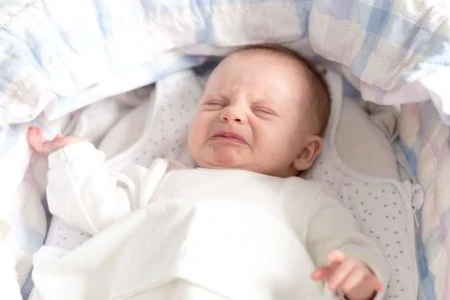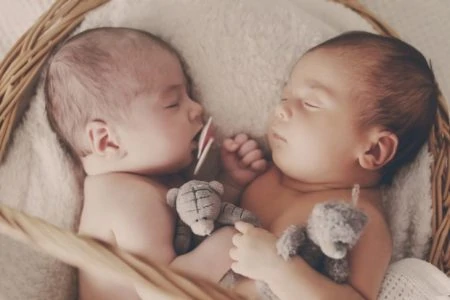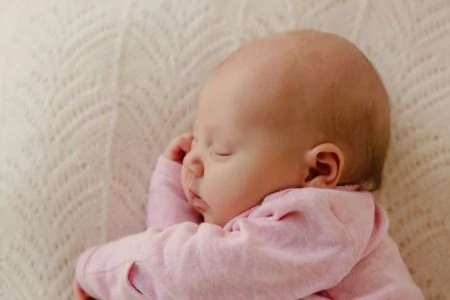Are you wondering if it’s safe for your child to begin sleeping with a blanket?
After all the training and reminders we moms receive about leaving everything out of the crib to prevent suffocation, we begin to wonder if our child will be sleeping on a bare mattress forever.
Don’t worry! You can add pillows and blankets to your little one’s sleep routine — but only when the time is right.
In this guide, we will discuss when your baby can use pillows and blankets and how to introduce them.
Key Takeaways
- Blankets and pillows pose suffocation risks and are linked to sudden infant death syndrome (SIDS) for babies under one year old.
- Introduce blankets between the ages of 1 and 2 when your child has improved motor skills and can move objects on or off freely.
- Wait until your child is 18-24 months old before introducing pillows, ideally when transitioning from a crib to a toddler bed.
- Practice safe sleeping habits, like limiting crib clutter, not co-sleeping, and creating a bedtime routine for your child.
Why Blankets Are Dangerous for Babies
Navigating every risk for babies and toddlers can be an exhausting commitment, but it’s one we parents make wholeheartedly. Children can bring us into a whole new world of worry — from swaddling dangers to bedding concerns.
The presence of blankets, pillows, and other objects in cribs has been linked to sudden infant death syndrome (SIDS). For this reason, they’re a dangerous inclusion to your child’s sleeping area for the first year of life.
Additionally, objects like pillows, toys, or bumper pads can pose a serious suffocation risk (1).
The following may also pose a risk of suffocation to children under one year:
- Mobiles: If you have a mobile over your baby’s crib, check often to ensure it’s secure, won’t fall, and is safely out of your baby’s reach.
- Sheets: Even thin, light sheets can be dangerous for a small baby. Ensure you buy the exact size of fitted crib sheets for your baby’s mattress.
- Car seats: Putting your baby carrier in the crib is extremely dangerous. It can tip or fall over, crushing or suffocating your baby.
When Can I Introduce Blankets?
Dangers associated with SIDS reduce drastically after one year, but they don’t disappear entirely. Every child advances at their own speed. Your child will be ready for blankets, pillows, and stuffed animals at a different time than your neighbor’s baby.
The short answer? When your baby has improved their motor skills enough to move around and pull things on or off freely, you can give them a blanket. This will happen sometime between the age of 1 and 2.
Blankets provide warmth, so if you find your baby is cold or needs additional comfort before this milestone, try swaddling them or putting them to bed in a sleep sack.
If they are past these milestones, it may be time to introduce a blanket. Ensure it’s not too thick and doesn’t feature a heavy fringe.
When Can I Introduce Pillows?
Once your child moves from a bassinet or a crib to a toddler bed, you have free reign. They can have pillows, blankets, and stuffed toys — as long as they don’t include any choking hazards.
But it’s best to wait for this transition. A baby doesn’t need more than a flat, bare surface for sleeping. There’s little need for them to have a pillow, and with slight risks remaining, it isn’t always worth taking that chance.
Experts say that it isn’t until 18-24 months that all risks of pillows in cribs are eliminated (2). Younger babies with the ability to roll and move around may still be at risk for suffocation against a pillow until at least one year of age.
Safely Using Blankets and Pillows
Sleeping safety is essential, even past that one-year milestone.
Follow some simple safety practices to ensure a safe, happy slumber for your toddler:
1. Be Mindful
Just because they aren’t at risk for SIDS anymore doesn’t mean your child won’t get harmed another way. Once you’ve moved your toddler to a big kid bed and given them all the blankets and comfort animals they desire, you still have to be diligent about safety.
Jumbo-sized, heavy, thick blankets or pillows that don’t zip closed could be unsafe to kids under 3 years old.
2. Limit Crib Clutter
If your toddler is older than 1 and still in their crib, don’t allow them to have too much around them.
A small, thin blanket and one or two stuffies are enough. Use the promise of more sleeping pals to encourage them to transition to a toddler bed.
3. Start With a Lovie

Thin cloth blankets called lovies can be a good introduction to larger blankets. Find a good lovie, and supervise your child with it to give your toddler some comfort without posing a risk.
Test the lovie first, and keep a close watch on your little one in the first couple of days of use.
Safe Sleeping Practices
It’s important to stay proactive about sleep safety.
The older your child becomes, the more lax your rules can be. But here are some basic things to consider implementing through the development stages.
1. Beware of Climbers
Toddlers and babies who can climb out of their cribs and playpens — even after lowering the mattress — risk falling and getting hurt. Once you’ve noticed your child has progressed to this point, pick out a toddler bed or a twin bed with secure rails to keep them from falling.
2. Don’t Co-Sleep
Though babies over the age of 1 aren’t at risk for SIDS, co-sleeping still isn’t a good idea. You and your baby need to continue to sleep separately. It may even be time to move them to their own room so they can self-soothe and practice independent sleeping habits early on.
3. Keep Their Bed Sippy-Free
My toddler was a sippy cup addict. Just getting the cup away from him at bedtime was a struggle. Still, it’s important you don’t put toddlers to bed with a sippy cup unless it’s full of water to help prevent tooth decay and cavities. Even then, it’s best to avoid it, or you risk the cup leaking or your child having bed-wetting problems.
4. Make Time-Out Separate
To avoid a negative association with bedtime, use an entirely different area for time-out and punishments. You want to make the bed a safe, peaceful place your child feels comfortable.
5. Create a Routine
Toddlers thrive with routine and dependability. Bedtime is made 100 times easier if you stick to a schedule and implement a simple, basic series of steps before going to bed. That way, it’s never a surprise, and your toddler won’t fight it as much.
FAQs
Is It Time For a Rest?
There’s no magic age your child can safely sleep with pillows, blankets, or stuffed animals. The trick is to keep an eye on their development and gauge what they need and what they’re ready for as you go.
After a year, feel free to use thin blankets in your baby’s crib when they’re napping. But the best time to bring other comforts into the mix is when your child moves from a crib to a toddler bed.











